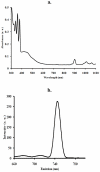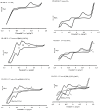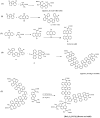Synthesis and characterization of a heteroleptic Ru(II) complex of phenanthroline containing oligo-anthracenyl carboxylic acid moieties
- PMID: 20957086
- PMCID: PMC2956087
- DOI: 10.3390/ijms11093158
Synthesis and characterization of a heteroleptic Ru(II) complex of phenanthroline containing oligo-anthracenyl carboxylic acid moieties
Abstract
In an effort to develop new ruthenium(II) complexes, this work describes the design, synthesis and characterization of a ruthenium(II) functionalized phenanthroline complex with extended π-conjugation. The ligand were L(1) (4,7-bis(2,3-dimethylacrylic acid)-1,10-phenanthroline), synthesized by a direct aromatic substitution reaction, and L(2) (4,7-bis(trianthracenyl-2,3-dimethylacrylic acid)-1,10-phenanthroline), which was synthesized by the dehalogenation of halogenated aromatic compounds using a zero-valent palladium cross-catalyzed reaction in the absence of magnesium-diene complexes and/or cyclooctadienyl nickel (0) catalysts to generate a new carbon-carbon bond (C-C bond) polymerized hydrocarbon units. The ruthenium complex [RuL(1)L(2)(NCS)(2)] showed improved photophysical properties (red-shifted metal-to-ligand charge-transfer transition absorptions and enhanced molar extinction coefficients), luminescence and interesting electrochemical properties. Cyclic and square wave voltammetry revealed five major redox processes. The number of electron(s) transferred by the ruthenium complex was determined by chronocoulometry in each case. The results show that processes I, II and III are multi-electron transfer reactions while processes IV and V involved one-electron transfer reaction. The photophysical property of the complex makes it a promising candidate in the design of chemosensors and photosensitizers, while its redox-active nature makes the complex a potential mediator of electron transfer in photochemical processes.
Keywords: conjugation; electrochemistry; oligoathracene; palladium; polypyridyl ligands; ruthenium complex; spectroscopy.
Figures










Similar articles
-
A high molar extinction coefficient mono-anthracenyl bipyridyl heteroleptic ruthenium(II) complex: synthesis, photophysical and electrochemical properties.Molecules. 2011 Jun 3;16(6):4615-31. doi: 10.3390/molecules16064615. Molecules. 2011. PMID: 21642936 Free PMC article.
-
Synthesis, photophysical and electrochemical properties of a mixed bipyridyl-phenanthrolyl ligand Ru(II) heteroleptic complex having trans-2-methyl-2-butenoic acid functionalities.Molecules. 2011 Sep 30;16(10):8353-67. doi: 10.3390/molecules16108353. Molecules. 2011. PMID: 21963625 Free PMC article.
-
Synthesis and photophysical and electrochemical properties of functionalized mono-, bis-, and trisanthracenyl bridged Ru(II) bis(2,2':6',2"-terpyridine) charge transfer complexes.ScientificWorldJournal. 2014;2014:570864. doi: 10.1155/2014/570864. Epub 2014 Apr 30. ScientificWorldJournal. 2014. PMID: 24883408 Free PMC article.
-
Synthesis and characterization of a Ru(II) complex with functionalized phenanthroline ligands having single-double linked anthracenyl and 1-methoxy-1-buten-3-yne moieties.Molecules. 2010 Oct 27;15(11):7570-81. doi: 10.3390/molecules15117570. Molecules. 2010. PMID: 21030910 Free PMC article.
-
Critical Overview of the Use of Ru(II) Polypyridyl Complexes as Photosensitizers in One-Photon and Two-Photon Photodynamic Therapy.Acc Chem Res. 2017 Nov 21;50(11):2727-2736. doi: 10.1021/acs.accounts.7b00180. Epub 2017 Oct 23. Acc Chem Res. 2017. PMID: 29058879 Review.
Cited by
-
Leishmanicidal and Immunomodulatory Activities of the Palladacycle Complex DPPE 1.1, a Potential Candidate for Treatment of Cutaneous Leishmaniasis.Front Microbiol. 2018 Jul 3;9:1427. doi: 10.3389/fmicb.2018.01427. eCollection 2018. Front Microbiol. 2018. PMID: 30018604 Free PMC article.
-
A high molar extinction coefficient mono-anthracenyl bipyridyl heteroleptic ruthenium(II) complex: synthesis, photophysical and electrochemical properties.Molecules. 2011 Jun 3;16(6):4615-31. doi: 10.3390/molecules16064615. Molecules. 2011. PMID: 21642936 Free PMC article.
-
Dibenzotropylium-Capped Orthogonal Geometry Enabling Isolation and Examination of a Series of Hydrocarbons with Multiple 14π-Aromatic Units.J Am Chem Soc. 2023 Feb 1;145(4):2596-2608. doi: 10.1021/jacs.2c12574. Epub 2023 Jan 6. J Am Chem Soc. 2023. PMID: 36606368 Free PMC article.
-
Synthesis, photophysical and electrochemical properties of a mixed bipyridyl-phenanthrolyl ligand Ru(II) heteroleptic complex having trans-2-methyl-2-butenoic acid functionalities.Molecules. 2011 Sep 30;16(10):8353-67. doi: 10.3390/molecules16108353. Molecules. 2011. PMID: 21963625 Free PMC article.
-
Synthesis and photophysical and electrochemical properties of functionalized mono-, bis-, and trisanthracenyl bridged Ru(II) bis(2,2':6',2"-terpyridine) charge transfer complexes.ScientificWorldJournal. 2014;2014:570864. doi: 10.1155/2014/570864. Epub 2014 Apr 30. ScientificWorldJournal. 2014. PMID: 24883408 Free PMC article.
References
-
- Juris A, Balzani V, Barigelletti F, Campagna S, Belser P, Zelewsky AV. Ruthenium(II) polypyridine complexes: photophysics, photochemistry, electrochemistry, and chemiluminescence. Coord. Chem. Rev. 1988;84:85–277.
-
- Juris A, Campagna S, Balzani V, Gremaud G, Zelewsky AV. Absorption spectra, luminescence properties, and electronchemical behaviour of tris-heteroleptic ruthenium(II) polypyridine complexes. Inorg. Chem. 1988:3652–3655.
-
- Prasanna de Silva A, Fox DB, Moody TS, Weir SM. Luminescent sensors and photonic switches. Pure Appl. Chem. 2001;73:503–511.
-
- Robertson N, McGowan CA. A comparison of potential molecular wires as components for molecular electronics. Chem. Soc. Rev. 2003;32:96–130. - PubMed
-
- Balzani V, Bolletta F, Ciano M, Maestri M. Electron transfer reactions involving light. J. Chem. Ed. 1983;60:447.
Publication types
MeSH terms
Substances
LinkOut - more resources
Full Text Sources
Research Materials
Miscellaneous

